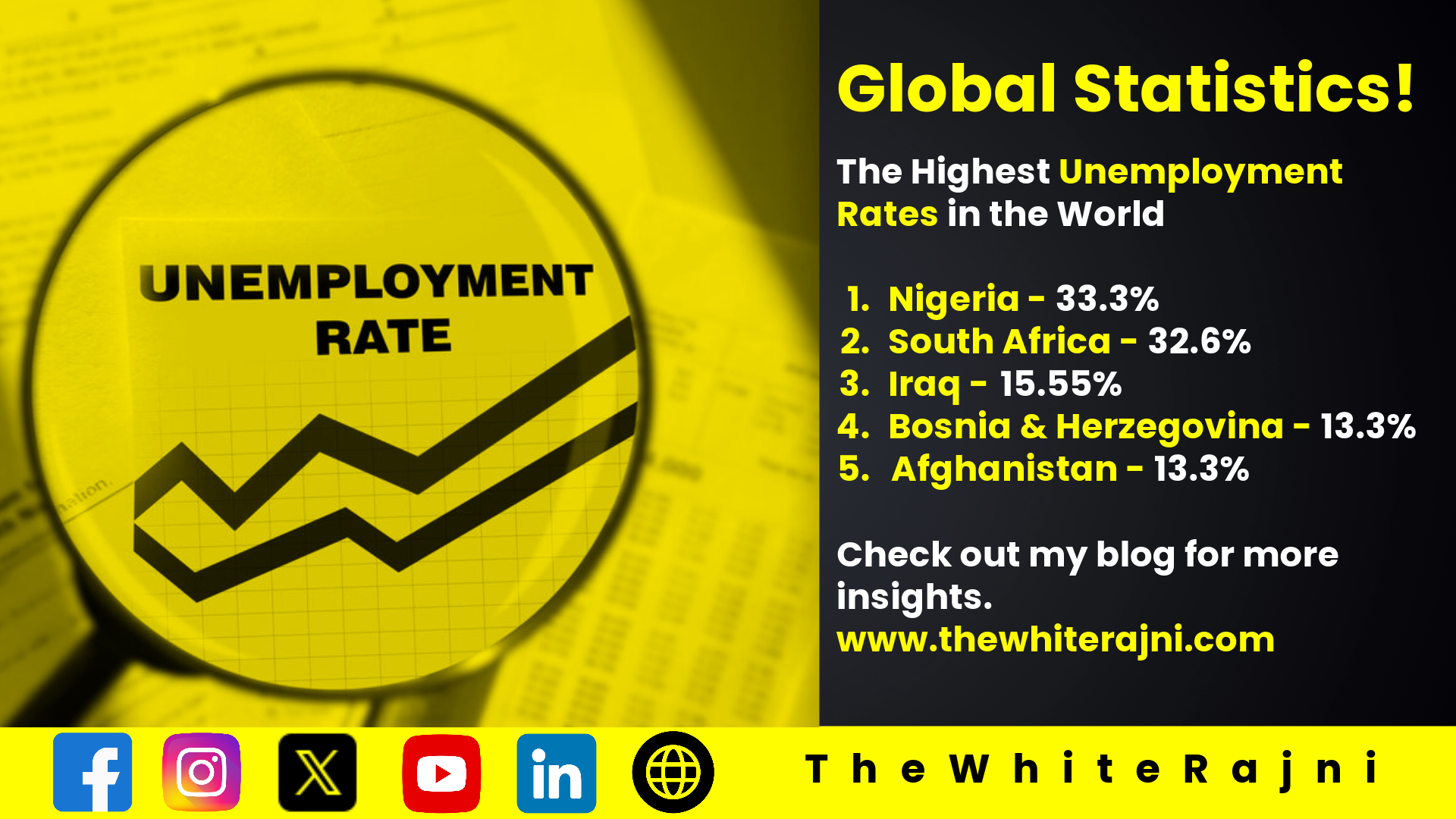Unemployment is a global concern, reflecting the number of individuals actively seeking employment but unable to secure jobs. The severity of unemployment varies widely from nation to nation, influenced by an array of factors including economic conditions, government policies, and social dynamics. Let’s examine the countries with the highest unemployment rates in 2023:
| Rate | Flag | Country | Unemployment Rate (2023) |
|---|---|---|---|
| 1 | 🇳🇬 | Nigeria | 33.3% |
| 2 | 🇿🇦 | South Africa | 32.6% |
| 3 | 🇮🇶 | Iraq | 15.55% |
| 4 | 🇧🇦 | Bosnia and Herzegovina | 13.3% |
| 5 | 🇦🇫 | Afghanistan | 13.3% |
| 6 | 🇪🇸 | Spain | 11.6% |
| 7 | 🇬🇷 | Greece | 11.1% |
| 8 | 🇺🇦 | Ukraine | 10.5% |
| 9 | 🇮🇷 | Iran | 9.7% |
| 10 | 🇹🇷 | Turkey | 9.6% |
| 11 | 🇨🇴 | Colombia | 9.34% |
| 12 | 🇸🇪 | Sweden | 9.2% |
| 13 | 🇨🇱 | Chile | 8.53% |
| 14 | 🇺🇾 | Uruguay | 8.2% |
| 15 | 🇧🇷 | Brazil | 8% |
| 16 | 🇮🇳 | India | 8% |
| 17 | 🇮🇹 | Italy | 7.4% |
| 18 | 🇫🇮 | Finland | 7.2% |
| 19 | 🇫🇷 | France | 7.2% |
| 20 | 🇪🇬 | Egypt | 7.1% |
| 21 | 🇦🇷 | Argentina | 6.9% |
| 22 | 🇵🇾 | Paraguay | 6.5% |
| 23 | 🇪🇺 | Euro area | 6.4% |
| 24 | 🇻🇪 | Venezuela | 6.4% |
| 25 | 🇵🇰 | Pakistan | 6.3% |
| 26 | 🇵🇹 | Portugal | 6.1% |
| 27 | 🇦🇹 | Austria | 5.9% |
| 28 | 🇧🇪 | Belgium | 5.7% |
| 29 | 🇩🇪 | Germany | 5.6% |
| 30 | 🇨🇦 | Canada | 5.5% |
| 31 | 🇮🇩 | Indonesia | 5.45% |
| 32 | 🇨🇳 | China | 5.3% |
| 33 | 🇸🇦 | Saudi Arabia | 5.1% |
| 34 | 🇵🇱 | Poland | 5% |
| 35 | 🇧🇩 | Bangladesh | 4.7% |
| 36 | 🇵🇭 | Philippines | 4.5% |
| 37 | 🇬🇧 | United Kingdom | 4.2% |
| 38 | 🇮🇪 | Ireland | 4.1% |
| 39 | 🇭🇺 | Hungary | 3.9% |
| 40 | 🇦🇺 | Australia | 3.7% |
| 41 | 🇳🇿 | New Zealand | 3.6% |
| 42 | 🇳🇱 | Netherlands | 3.6% |
| 43 | 🇺🇸 | United States | 3.5% |
| 44 | 🇨🇿 | Czechia | 3.5% |
| 45 | 🇳🇴 | Norway | 3.4% |
| 46 | 🇷🇺 | Russia | 3.1% |
| 47 | 🇰🇵 | North Korea | 3% |
| 48 | 🇰🇷 | South Korea | 2.8% |
| 49 | 🇦🇪 | United Arab Emirates | 2.75% |
| 50 | 🇲🇽 | Mexico | 2.7% |
| 51 | 🇯🇵 | Japan | 2.5% |
| 52 | 🇩🇰 | Denmark | 2.4% |
| 53 | 🇻🇳 | Vietnam | 2.3% |
| 54 | 🇨🇭 | Switzerland | 1.9% |
| 55 | 🇸🇬 | Singapore | 1.9% |
| 56 | 🇹🇭 | Thailand | 1.06% |
| 57 | 🇳🇪 | Niger | 0.5% |
| 58 | 🇰🇭 | Cambodia | 0.36% |
| 59 | 🇶🇦 | Qatar | 0.1% |
As you can see, the unemployment rate varies significantly from country to country. The countries with the highest unemployment rates are typically those that are experiencing economic hardship or political instability.
There are a number of factors that can contribute to high unemployment rates, including:
- Economic recession: When the economy is in a recession, businesses are less likely to hire new employees.
- Government policies: Government policies, such as high taxes or regulations, can make it more difficult for businesses to hire new employees.
- Social factors: Social factors, such as discrimination or lack of education, can make it more difficult for some people to find jobs.
High unemployment rates can have a number of negative consequences for a country, including:
- Reduced economic growth: When people are unemployed, they are not able to spend money, which can slow down economic growth.
- Increased poverty: Unemployed people are more likely to live in poverty.
- Social unrest: High unemployment rates can lead to social unrest, such as protests or riots.
There are a number of things that can be done to address high unemployment rates, including:
- Fiscal stimulus: Governments can use fiscal stimulus, such as tax cuts or spending increases, to boost the economy and create jobs.
- Regulation reform: Governments can reduce regulations that make it difficult for businesses to hire new employees.
- Investment in education and training: Governments can invest in education and training to help people develop the skills they need to find jobs.
- Social programs: Governments can provide social programs, such as unemployment benefits, to help people who are unemployed.
Addressing high unemployment rates is a complex challenge, but it is important to take steps to address this issue in order to promote economic growth and social stability.










